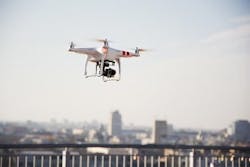Physical security: top predictions, trends for 2024
As the new year begins, the threat environment across North America and the globe has arguably never been so complex, from election integrity and deep fakes to drone swarms, ransomware and mass shootings.
The amplification of hate groups, political polarization, wars in Europe and the Middle East and the devastating impact of ubiquitous cyber gangs have created risks at nearly every turn. That means the security industry will have to perform brilliantly in 2024 to prevent widespread chaos and loss of life.
Chris Hurst, OnSolve’s Vice President of Value Engineering, says security leaders must be ready for multiple critical events to happen simultaneously – and even for one event to have a ripple effect that causes other unforeseen incidents.
With the onset of the war in Ukraine in 2022 and the Israel-Gaza war in 2023, Hurst believes cracks have begun to emerge in the larger global order. Hurst says two major international trends are competing against each other – isolationism vs. multilateralism – as leaders of nations begin to question what their real responsibilities are outside of their borders.
Hurst says uncontrollable threats like these are where organizations and agencies are most vulnerable, as they can have a cascading impact on trade, the environment and climate. But a proactive strategy combined with modern technology can strengthen preparedness, he says.
He believes organizational and agency leaders may anticipate an increase in protests during the week of the election this fall, citing an analysis of the historical risk data from the week of the 2020 elections (Nov. 1-7, 2020) supports this assumption, uncovering a 250% increase in reports of protests compared to the two weeks before the election.
However, the data also shows that other types of physical threats are also likely to increase during this time, he says. Specifically, reports of explosions increased by 220%, while reports of shootings increased by 65% and reports of arson increased by 38%.
The security industry will again have to be prepared for extreme weather and natural disasters that could take a toll on organizations and agencies, from both a financial and continuity perspective, Hurst says. Events like the Indonesian Tsunami and Hurricane Katrina marked the beginning of an increase in the frequency of billion-dollar natural disasters, but he notes a new record was set in 2023 with 25 such events as of early December.
The lesson for security and resilience practitioners? The uncommon has become common.
“Security leaders will need to leverage technology to anticipate shifting patterns and allocate appropriate response resources,” Hurts says.
Retail Execs Come to Grips
with Impact of Violence
Additionally, public and private efforts to combat escalating concerns over crime and violence in America will gain even greater traction in 2024, Hurst predicts.
While there are differing opinions about the main factors contributing to the rise of violence in America, what’s not debatable is the data, he says: statistics show that active shooter events/mass shootings are a persistent threat to residents and businesses across the country.
The mass shooting in Lewiston, Maine, in which 18 people were killed is just one of the more than 640 mass shootings in 2023 as of mid-December.
Mass shootings aren’t the only evidence of rising violence. Vehicle thefts are on the rise, increasing by 33.5% during the first half of 2023 when compared to the same timeframe in 2022.
Retailers have also been experiencing increasing crime rates in the past few years due to incidents like smash-and-grabs. Organized retail crime (ORC) in particular is seeing an alarming uptick and has become a “multi-billion-dollar problem, Hurst laments.
Retailers are suffering from increasing shrink rates, and these issues of theft and crime are impacting the industry at “unprecedented levels,” he says. Unfortunately, some well-known retailers are pulling out of areas with high crime rates, threatening the economic stability of the local community.
“While issues like these used to fall primarily to security teams, executives are now recognizing the far-reaching impacts of violence and are searching for proactive measures to protect their employees and bottom line,” Hurst explains.
“Cities, states and the federal government are also reviewing policies for improved enforcement, resourcing and coordination. These efforts will continue throughout 2024.”
Reality Check Coming for AI?
The proliferation of AI capabilities is changing nearly every facet of physical security, from the way video surveillance works, to how threats and anomalies are detected or access control is meted out to minimize risk.
Peter Evans, CEO of Xtract One Technologies, notes the booming market for AI security solutions is projected to reach $50.6 billion USD by 2028, propelled by a CAGR of 19%.
He anticipates AI this year will shift from a “trendy buzzword” to practical, purpose-built applications, aligning with a recurring trend in tech innovation. He thinks AI will be different than technologies that had inflated expectations -- such as Segway and Google Glass -- with “specific applications that effectively address real-world problems.”
Evans also predicts generative AI’s imminent mainstream adoption in 2024 as its potentially redefines how society creates, designs and innovates. “The ripple effects across industries could be comparable to the revolutionary changes brought about by the internet, shaping how we work, communicate, and interact,” he says.
The emergence of customizable AI on-site learning could usher in the next level of AI adoption in 2024 in physical security, according to Adam Lowenstein, Americas Product Director at i-PRO. While AI-based security cameras have been able to significantly reduce errors by reliably detecting humans and vehicles for some time, the next phase of AI “will be irresistible to data hungry businesses,” says Lowenstein says.
“On-site AI training of edge devices can further enhance accuracy by recognizing logos on vehicles or uniforms, counting planes, forklifts, baby strollers,” and other items, Lowenstein says. “This new stream of business intelligence data, harvested directly utilizing edge processing within security cameras, will enable more automated workflows while increasing operational efficiency and enhancing service quality.
“AI-based systems will soon be able to detect when people need assistance or notify when a floor is wet to prevent people from slipping for example.”
Mike Wilson, founder and CTO of Enzoic, says he believes AI will get more positive press in 2024 as it will be used to combat cyberattacks by helping organizations adopt a more proactive security posture. “For example,” he says, “large language models will increasingly be deployed to sort through large quantities of data quickly — enabling companies to leverage security analysis resources more effectively.
“Threat data can now be analyzed at a previously impossible scale and can unlock new insights, especially when combined with other big data techniques.”
End to the AI ‘Marketing Hoopla’
On the other hand, Wilson predicts the “nonstop marketing hoopla” over AI will grind to a halt soon.
“Its capabilities have been drastically oversold and the coming year is when the hype machine will falter,” Wilson predicts. “It’s a mistake to look at innovations such as ChatGPT and extrapolate it forward to predict AI will continue that trajectory this year and beyond.
AI will plateau, and then several years down the road, there will be another significant leap. But it’s not going to deliver on the potential promised by the current hype machine for a very long time.
“The technology will plateau and then several years down the road, there will be another significant leap – but it’s not going to deliver on the potential promised by the current hype machine for a very long time.”
A shift of weapons detection systems from specific applications to mainstream requirements will also occur this year, Evans notes.
Like fire alarms and access badges, organizations will begin to mandate proactive AI-driven systems for preventing weapon-related incidents. This shift will create a demand for next-generation solutions that scale cost-effectively and provide advanced insights, ushering in a new era of security protocols, he says.
Simon Bain, CEO at web3 and Omnilndex, believes the environment and private data security will become issues with AI as well. He believes tech’s environmental impact will influence buying decisions more than ever.
While Google and Microsoft have made commitments to remove their carbon legacy as well as reach net-zero, Bain says AI and large-language models (LLMs) like ChatGPT and Bard “potentially threaten this pledge and buck the trend with their reportedly huge emissions.
Estimates vary from source to source, but research suggests an AI query with an LLM is four to five times bigger than a traditional search engine query.
“What’s more,” he adds, “the emissions come not just from the ongoing cost of operating the AI and user’s accessing it, but from the up-front cost to build and train it.” One reported figure for the up-front costs suggested GPT-3, the model behind the original ChatGPT, had similar emissions to two or three full Boeing 767s doing round trips from New York City to San Francisco.
“One way being talked about is to look at greener energy and optimizing algorithms to make the current solutions as lean as possible,” Bain says. “But in reality, a more dramatic approach is needed to truly cut down how much energy is needed for the training and use – especially when you consider the needs for these services to work just as quickly and accurately in multiple languages.
“Small-language models are one potential solution, because they work with zero training and are designed to produce powerful and accurate results for particular tasks as opposed to being generic ‘jack of all trades’ solutions that require huge computational power and training to try and cover all potential queries.”
Tool for Heightened Detection
AI is also likely to see an increased role in threat intelligence, anomaly detection, red team testing, incident response simulations and more – which means the data sets are of utmost importance, says Patrick Hayes, Chief Strategy and Product Officer at Third Wave Innovations.
“We have a responsibility to adequately train models against appropriate data sets, while continuously testing for accuracy, especially if any automated response is involved,” Hayes notes.
“Adversaries are more than equally using AI in their tactics, techniques and procedures to attack our organizations. The difference is that attackers have no boundaries when developing their strategies and are often way ahead of the curve.”
The day will come, he says, when AI will evolve to self-protect and defend organizations.
“Alternatively, we will see attacks that are not necessarily initiated by humans, rather AI continuing to evolve in its training. The fact is AI lacks empathy for the human condition, and, without this, AI can only process the world based on the available data presented,” Hayes says.
Physical Safety Drives
More Access Control Solutions
Physical safety amidst an evolving threat landscape will continue to remain a top priority, especially for schools that have seen repeated attacks from mass shooters.
Evaluating campus vulnerabilities and threats then taking further action as necessary will no longer be the job of one, according to leaders at Johnson Controls.
“Integrated, digital building assessments will take an ‘always on’ approach, helping to provide stronger visibility into the safety of the school, and helping leaders take the appropriate actions to both prevent and respond to incidents,” says Greg Parker, Vice President of Life Cycle Solutions, Fire & Security, at Johnson Controls.
Security integrators need to be ready for more customers to demand and expect their access control solution to function as a ‘single pane of glass’ for disparate security systems and applications,” noted Mary Clark, Chief Marketing Officer at Brivo.
“Platforms that centrally host video management, license plate recognition, building management software, elevator monitoring, hot desking solutions and more reduce touchpoints and break down silos between data.
“This strong push for centralization reflects a wider trend of increasing API utilization across the entire enterprise landscape. These expectations haven’t missed the shores of physical security.”
Clark also believes integrators must become subject matter experts about their ecosystem and know what a ‘single pane of glass’ means for the “network back end – effective API integrations in cloud-based platforms.
“It’s with enterprises and large enterprises particularly where integrators are in a fantastic position to show the beauty of scaled-up cloud infrastructure and do more with this – including better leveraging organizational data. In short, access control tech stacks are changing. And that’s to be embraced.”
Video Surveillance Continues Evolution
Even more power in video surveillance will come to the edge this year, as cameras emerged with more powerful processors to process video data, Lowenstein predicts.
Edge devices will soon be able to collaborate and combine their computer resources in ways similar to racks of servers in the cloud today.
“This will enable significantly more processing capabilities without overburdening the network and supporting infrastructure,” the company says. “Backend server expense will stay relatively low as more processing of AI-based analytics happens within edge devices like cameras and less video gets streamed back to servers for analysis.
“Enhanced edge processing will also make cloud-based systems more efficient and less costly to operate.
Organizations will be under increased pressure in 2024 to invest in solutions that don’t become obsolete shortly after they’re installed, or that limit them through closed platforms.
i-PRO advises seeking out vendors and manufacturers with open platforms that collaborate freely with multiple third-party manufacturers.
“Equipment should be designed to take advantage of evolutions in AI and analytics without forklift upgrades,” Lowenstein says. “By focusing on retrofitting, upgrading, and integrating existing equipment with new technology in a phased approach, companies can maximize the life of existing equipment while also adding new capabilities such as bringing AI to non-AI devices.”
Drones Face Promise, Regs
In addition to improvements in traditional technologies like video surveillance, the security industry is just beginning to leverage the possibilities offered by unmanned aerial vehicles, or drones, in taking over routine law enforcement monitoring tasks, proactively defending sensitive targets or even rendering aid to someone.
Mary-Lou Smulders, CMO at Dedrone, says drone flying beyond the visual line of sight without a physical observer is very tough right now, but technology is being piloted that enables DFR operations without visual observers to occur.
“This allows more opportunities for first responders to use drones to assess a situation, be the first to arrive on the scene, and use overall resources more efficiently,” Smulders says.
Critical infrastructure will heavily invest in airspace security, she predicts, as increased polarization during an election year makes the odds of homegrown bad actors looking to disrupt critical infrastructure more likely.
“If an incident occurs, this will drive more and faster investment into protecting airspaces at power plants and other key facilities, but even if there isn’t such an inciting event, we are seeing more companies and institutions taking these threats seriously,” she said.
In March 2024, Remote ID (RID) will be fully enforced across the U.S., but public safety and national security agencies alike will quickly realize its shortcomings, Smulders predicts.
“Like a license plate on a vehicle, bad actors will simply stop RID transmissions or spoof the signal, similar to changing a license plate’s characters,” she says. “These shortcomings will mean that some malicious drone pilots can’t be prosecuted or caught unless there’s more than just Remote ID in place.”
The velocity of innovation is accelerating across the world and drone technology / airspace security solutions are no exception. Winning companies on both sides will be the ones that set the pace for these innovation cycles.
Companies participating in the global conflict areas will be setting the pace for innovation as more money pours in from governments racing to get their hands on the best tech and more feedback comes from customers, Smulders says, adding the industry should “expect a quantum leap in terms of drone and counterdrone capabilities in 2024.”
John Dobberstein is managing editor of SecurityInfoWatch.com and oversees all content creation for the website. Dobberstein continues a 34-year decorated journalism career that has included stops at a variety of newspapers and B2B magazines.
About the Author
John Dobberstein
Managing Editor/SecurityInfoWatch.com
John Dobberstein is managing editor of SecurityInfoWatch.com and oversees all content creation for the website. Dobberstein continues a 34-year decorated journalism career that has included stops at a variety of newspapers and B2B magazines. He most recently served as senior editor for the Endeavor Business Media magazine Utility Products.





